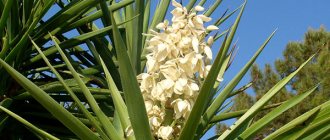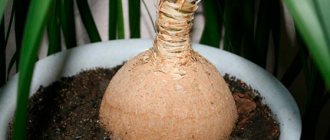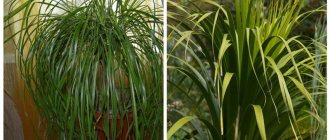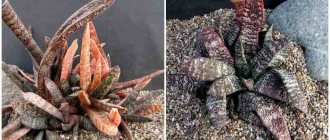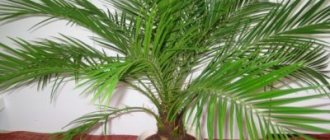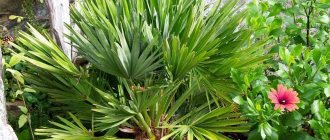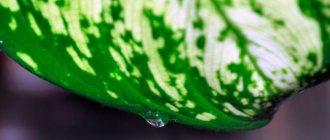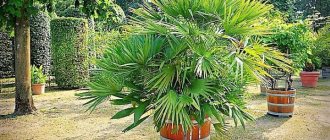Hamerops is widely known in many countries.
It is often used for planting in open ground if natural conditions allow it. Because of its size, this palm tree looks advantageous in large areas and in rooms with a large area. If you provide proper care, chamerops is also well suited for growing in a winter garden, greenhouse, or home.
Chamaerops belongs to the Palm family. However, the plant rarely grows as tall as a tree; more often it is a shrub, the maximum length of which is 3 meters. Moreover, each cutting has 10 - 20 leaves up to one and a half meters in length.
The homeland is the Mediterranean. Hamerops is often referred to as the European fan palm, because. The plant also serves as a decoration for parks in European countries: France, Italy, Spain.
Description and photo
This genus of palm trees is considered monotypic, consisting of one species - Hamerops squat (Humilis) and, in comparison with other representatives of its family, is unpretentious. Below is a description and photo of Hamerops squat, the secrets of breeding and caring for it at home.
The trunk is hard, fibrous, and brownish in color. The crown of the plant consists of fan-shaped, voluminous leaves of bright green color. The inflorescences are small - only 25 cm in length, inconspicuous in appearance , but the luxurious foliage compensates for this shortcoming. After flowering, the plant produces small yellow-brown fruits.
This exotic beauty prefers sandy or rocky soil and plenty of sunlight. It tolerates lack of heat without problems and is rightfully considered the northernmost palm tree in the world.
The photo below shows Hamerops squat (Humilis) in natural conditions:
In the photo below, Hamerops is squat, popularly short, grown in a pot:
Varieties of indoor plants similar to palm trees
Today, a variety of palm-shaped, ornamental plants are very popular in the home interior, which, due to the presence of a lignified and leafless stem with a bunched arrangement of leaves in the non-apical part, are called false palms:
- elephant-footed yucca, aloe-leaved yucca, angustifolia yucca, glaucous yucca and fibrous yucca;
- pandanus vecha, pandanus useful and pandanus sandera;
- Dracaena Marginata, Dracaena fragrant, Dracaena "Song of India", Dracaena Lime, Dracaena Dereme, Dracaena Canary, Dracaena Godseph, Dracaena Golden, Dracaena Recurta, Dracaena Surculosa and Dracaena Hooker;
- Cordyline shrubby, Cordyline undivided, Cordyline southern, Cordyline straight, Banks' Cordyline;
- bocarnea nolina;
- some varieties of Dieffenbachia.
Pseudopalms are completely unpretentious, so they can become a completely worthy and affordable alternative to tall and slow-growing indoor real palms.
Care
When growing at home, you should always know all the nuances of caring for a Mediterranean palm tree and follow all the rules for its maintenance. We'll talk about this further.
You should know that in the first 4 days after purchasing a plant, you need to refrain from all possible manipulations with it: watering, replanting and fertilizing.
Lighting
Chamerops prefers a lot of light, despite the fact that this plant is shade-tolerant. The shrub is not afraid of direct sunlight , so you can safely take it out onto an open balcony or plant it in a garden or summer cottage.
Temperature
To grow successfully at home, the palm tree will need warmth. 23-25 degrees is the optimal temperature for Hamerops. However, in winter it should be kept cool at a temperature of 6-10 degrees.
Ventilate the room regularly, but avoid drafts.
Humidity and watering
In the summer heat, chamerops requires abundant watering, but in winter, watering should be reduced. It is important to adhere to the rule here: the brighter the light in the room and the higher the air temperature in it, the more intense the watering should be .
The air humidity should be high. The palm tree should be sprayed every day, and sometimes given a warm shower.
Watering is reduced when the summer season changes to winter. During this period it should be moderate, not abundant. It is also not worth moisturizing the chamerops.
Transfer
Hamerops does not like replanting, so the procedure should be carried out only when the roots become cramped in the pot.
They rejuvenate the old plant in the spring and summer. Replanting is carried out once every 4-5 years as the palm tree grows . The young palm tree is replanted after 2-3 years in the spring.
In order for the plant to grow healthy, it is recommended to update the soil once a year. To do this, remove the top part of the old soil and fill the pot with new.
Priming
The soil for growing young plants should consist of leaf (humus) soil and river sand in equal proportions. An adult palm tree is transplanted into harder soil, consisting of clay turf and leaf soil in equal proportions.
Growing adult plants requires half as much sand as young plants.
The ideal place for growing chamerops would be a spacious tub placed on a balcony, summer veranda or outdoors - where there are no drafts.
To grow chamerops, you can purchase a ready-made substrate for palm trees.
Top dressing
Mineral fertilizers should be used for feeding. They are added weekly if the chamerops is grown on the balcony. In indoor conditions, it will be enough to fertilize 2 times a month. In winter, fertilizing is not required at all.
Rest period
In winter, maximum rest is required. The room where the palm tree will winter should be cool. You should not wet the leaves at this time, but you will need to remove dust from them with a sponge.
Types of nolina
Although there are about 30 species in the genus Nolina, it is mainly Nolina recurvata , also known as recurvata , that comes into stores. The trunk is erect, expanding downward, forming a bulbous thickening. Under natural conditions, the trunk reaches a height of 8-10 m - photo, the base is up to 1 m in diameter.
In a greenhouse-room culture, the height of the plant often does not exceed 1.5 m. In the upper part of the plant there is an abundant sheaf of dense linear leaves, reaching almost two meters in length. In its native Mexico, the long and strong leaves of nolina are used for weaving baskets and the famous sombrero hats. The lower part of the stem is exposed and covered with a smooth grayish cork tissue that protects against water evaporation.
Long-leaved Nolina (Nolina longifolia) and small-fruited Nolina (Nolina microcarpa) are found in greenhouses and parks on the Black Sea coast of the Caucasus and Crimea. There you can admire the long inflorescences of nolina from numerous small flowers.
Nolina (bocarnea) is a rather unpretentious plant, and growing it is not difficult even for beginners who like indoor floriculture. She feels best in a bright place, but direct sunlight should be avoided.
Nolina parryi. © Spidra Webster
Reproduction
Hamerops reproduce in the following ways:
- Using seeds;
- By shoots;
- Dividing the root.
Let's take a closer look at all the options.
Seeds
At home, when growing palm trees from seeds, it is important to maintain the temperature within 25-30 degrees.
The seeds are placed in pre-prepared soil to a depth of 1-2 centimeters and the pot is covered with damp moss. This plant takes quite a long time to germinate, so be patient. Strong shoots will appear only after 2-3 months.
The first leaves of the palm tree are whole. Fan leaves appear only in the 2nd year of life.
By shoots
Chamerops reproduces vegetatively using lateral shoots. They should be carefully separated so as not to touch the roots and planted in a prepared soil mixture for young plants.
After transplantation, chamerops requires more careful care associated with intensive watering and moistening of the leaves. Make sure that the soil in the pot does not dry out, but is moderately moist.
Root division
This method is suitable for propagating old chamerops , which have a strengthened root system. An adult plant is carefully removed from the pot and divided into parts, each of which should have healthy roots. Hamerops need to be replanted in hard soil, prepared in advance and well moistened.
Diseases and pests
Diseases common to chamerops are most often associated with improper care. Therefore, pay attention to the following signs:
- The leaves of the palm tree are drying up - most likely, the air in the room is too dry. You can spray the air around the plant, or it is better to purchase a special humidifier.
- Yellowing leaves indicate a lack of moisture in the soil. Water the plant more often and the leaves will look fresh.
- The appearance of brown spots on the leaves indicates waterlogging of the soil. Other reasons may include a sharp drop in room temperature and watering with hard water.
Like other plants, palm trees are prone to parasites. Most often, chamerops suffers from the appearance of pests such as:
- Scale insects - it can be found on almost any part of the plant in the form of tubercles measuring 2-5 mm. You can also find a sticky coating on the plant. It is better to fight scale insects with the help of intestinal preparations, because contact insecticides are ineffective due to the fact that pests are protected from them by waxy shields.
- Mealybug - often attacks chamerops in the same way as scale insects. When there is a large accumulation, colonies of parasites look like pieces of white cotton wool in the axils of leaves and shoots. Mealybugs should be dealt with in the same way as scale insects.
- Spider mites are the most common pest that affects indoor plants. The main signs of its presence are the formation of small grains on chamerops leaves. With severe damage, a web is visible. To prevent the appearance of spider mites, the plant is sprayed with cold water. Control methods include washing in the shower followed by treatment with acaricides (Vertimek, Fitoverm).
- Whiteflies are small white flies that can be seen on the back of leaves. To combat whiteflies, use the Aktara insecticide and yellow sticky traps.
When purchasing from a flower shop, chamaerops should be carefully inspected to identify any unwanted insects. After purchasing, even a seemingly healthy plant must be given a warm shower and placed separately from others for up to one month. After observation, a healthy flower can be added to the existing ones.
Problems when growing Hamerops
When errors occur in cultivation, problems arise that can be eliminated by adjusting the contents.
| Problem | Cause |
| The leaves wither, their tips turn brown and dry out. | Insufficient humidity. |
| Brown spots on greenery. |
|
| Brown leaves. | Overmoistening of the soil, stagnation of water. |
| The greens turn yellow. | Irregularity of watering. |
Photo gallery
nagima_flora
pitomnik_soc
tracktour1
white_eden_
sadoviy_centr_sadovod
cathain.md


